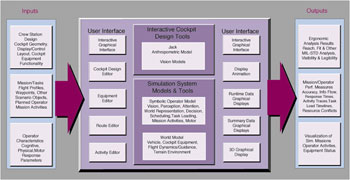 |
 |
 |
|
|
 |
|
| |
|
|
|
|
|
| |
Architecture
-
MIDAS
|
| |
|
|
|
|
|
| |
The
existing
system
contains
a
set
of
integrated
software
modules,
editors,
and
analysis
tools
produced
in
C,
C++,
and
Lisp,
with
an
architecture
based
in
agent-actors
theory.
Each
major
component,
or
agent,
contains
a
common
message
passing
interface,
a
body
unique
to
that
agent's
purpose,
and
a
common
biographer
structure
which
keeps
track
of
important
state
data
or
events
for
analysis.
This
uniform
representation
was
chosen
to
provide
modularity.
The
total
system
contains
350,000
executable
lines
of
code,
with
about
half
of
the
total
associated
with
a
dynamic
anthropometry
model.
Once
a
user
inputs
or
specifies
operator,
task,
and
equipment
characteristics,
MIDAS
operates
in
two
major
modes.
The
first,
Interactive
Mode,
supports
scenario-independent
layout
of
the
crew
station
for
assessments
of
visibility
and
legibility,examination
of
anthropometric
characteristics,
and
analyses
of
cockpit
topology
and
configuration.
The
output
of
MIDAS
in
this
mode
corresponds
to
cockpit
geometry
and
external
vision
design
guides,
such
as
MIL-STD-1472
and
AS-580B. |
|

User
View
of
MIDAS
(Click
for
Larger
View)
|
| |
| |
|
|
|
|
|
| |
The
other
analysis
path
supported
by
MIDAS
is
a
dynamic
simulation.
The
Simulation
Mode
provides
facilities
whereby
specifications
of
the
human
operator,
cockpit
equipment,
and
mission
procedures
are
run
in
an
integrated
fashion.
Their
execution
results
in
activity
traces,
task
load
timelines,
information
requirements,
and
mission
performance
measures
which
can
be
analyzed
based
on
manipulations
in
operator
task
characteristics,
equipment,
and
mission
context. |
| |
|
|
|
|
|
|
|
|
